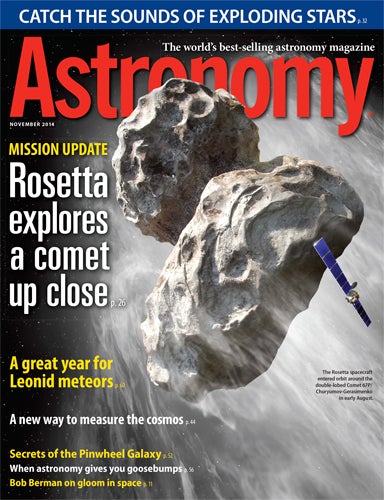
Astronomy offers you the most exciting, visually stunning, thorough, and timely coverage of the heavens above. Each monthly issue includes expert science reporting, vivid color photography, complete sky-event coverage, spot-on observing tips, informative equipment reviews, and more. All of this comes in an easy-to-understand user-friendly style that’s perfect for astronomers at any level. Contact Astronomy, the world’s best-selling astronomy magazine, at 262.796.8776 or email editor@astronomy.com.
WAUKESHA, Wis. – As we speak, something unprecedented is happening in our solar system. Some 286 million miles (460 million kilometers) away, a spacecraft pioneer is orbiting a 2.5-mile-wide (4km) comet to better understand these “dirty snowballs.” And its journey is only beginning.
On August 6, the European Space Agency’s Rosetta spacecraft became the first mission to orbit a comet – and not just fly by it – when it began studying Comet 67P/Churyumov-Gerasimenko up close. And the probe’s list of firsts won’t just end there. In “Rosetta sets its sights on comet mysteries,” Senior Editor Richard Talcott explores what it took to get the spacecraft to this point and previews its historic mission, which will last 17 months and involve a lander setting down on the comet’s surface this November. Project scientists equate what they’ve done so far with “finding a speck of dust in a big city.” Now their studies should help planetary scientists better understand the solar system’s origin and the role comets have played in it.
To learn more about Rosetta and its target, pick up the November issue of Astronomy, on newsstands October 7.
“Catch the sounds of exploding stars”
Yes, in the vacuum of space, we can’t hear a star explode, but that doesn’t mean sound can’t play a part in astronomers’ studies of supernovae. In fact, by converting multiwavelength observations into sound, scientists are discovering patterns in these events that they might have missed otherwise. In “Catch the sounds of exploding stars,” astrophysicist Raffaella Margutti explains this concept of “sonification” and what it has revealed to her and her colleagues about supernovae, in particular a weird explosion that began in 2009 and culminated in 2012.
“Secrets of the Pinwheel Galaxy”
Many unseasoned observers think the Pinwheel Galaxy (M33), the magnitude 5.7 Local Group member that lies 2.7 million light-years away in the constellation Triangulum, is simply one deep-sky target. In “Secrets of the Pinwheel Galaxy,” Rod Pommier shows how this couldn’t be more incorrect. With four bright nebulae and 10 star clouds visible through amateur telescopes, this spiral galaxy is one you could target for entire night.
“A great year for the Leonids”
Bundle up and head out to observe one of the year’s best meteor showers this November as the Leonids reach their peak. A waning crescent Moon won’t interfere much (moonlight drowns out fainter “shooting stars”), so viewers could see some 15 meteors per hour. Use Senior Editor Michael E. Bakich’s helpful guide, “A great year fort the Leonids,” to show you where to look and when, as well as helpful tips to make the most of a night counting shooting stars.
November sky events visible without optical aid
- November 1 – Mercury’s best morning appearance of 2014 reaches its pinnacle.
- November 14 – The Moon and Jupiter are a fine pair in the hours before dawn.
- November 17 – The annual Leonid meteor shower peaks under good Moon conditions.
Also in the November 2014 Astronomy
- “How astronomers measure the cosmos”: Sound waves at the beginning of time may help scientists find the universe’s expansion rate today.
- “When astronomy gives you goosebumps”: Sometimes our hobby is so cool, it gives you the chills.
- “Astronomy tests William Optics’ new refractor”: Superb craftsmanship and high-quality optics makes this a 4-inch telescope you’ll be proud to own.
- “The Sky this Month”: Exclusive star charts will guide you through November’s night sky.
- The November issue also features Snapshot, Breakthrough, Astro News, Ask Astro, Bob Berman’s Strange Universe, Glenn Chaple’s Observing Basics, Stephen James O’Meara’s Secret Sky, Adam Block’s Cosmic Imaging, Astro Sketching, New Products, Letters, Web Talk, Reader Gallery, and Final Frontier.









